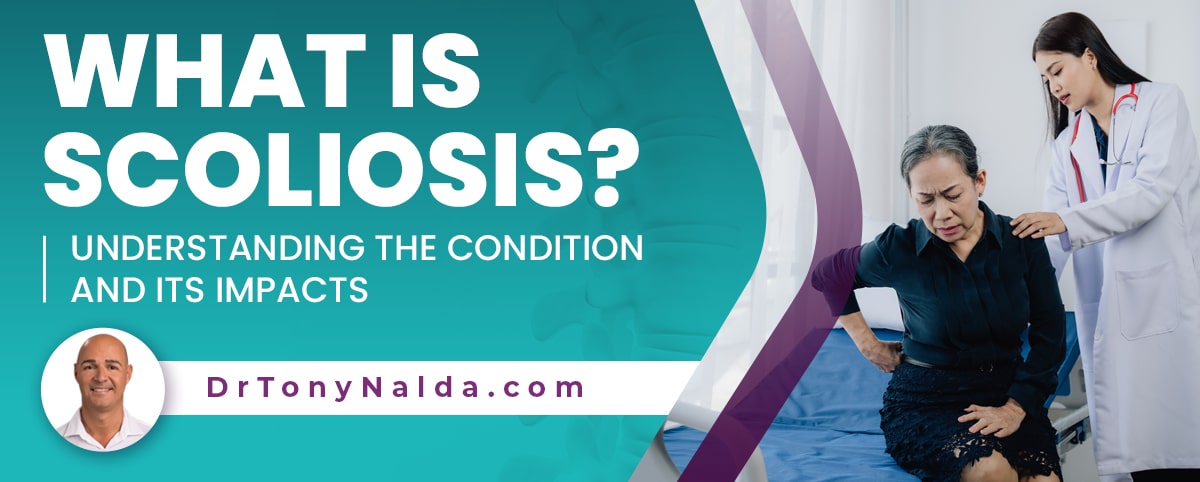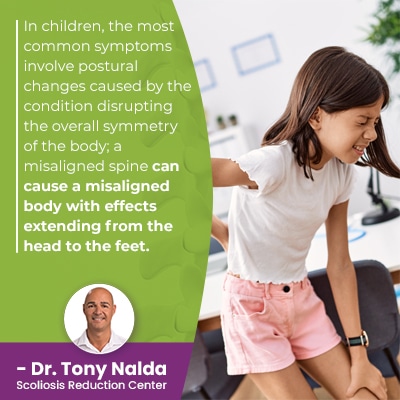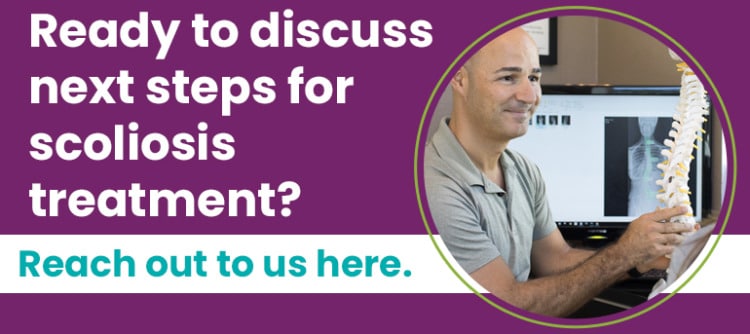What is Scoliosis? Understanding the Condition and Its Impacts

Understanding scoliosis is important because early detection has a number of benefits. A challenge to early detection can be the often-subtle symptoms of mild scoliosis, particularly in children. As a progressive condition, knowing the importance of starting treatment early is crucial.
Scoliosis is a structural spinal condition that causes the development of an unhealthy sideways curve of the spine that also rotates. As a progressive condition, its nature is to become more severe over time, and as progression is triggered by growth, children are more prone to rapid advancement.
Understanding scoliosis progression is important because this is where treatment can make the biggest impact.
Table of Contents
What is Scoliosis?
There are a number of spinal conditions that can cause a loss of its healthy curves, but scoliosis is particularly prevalent and has a number of unique characteristics.
Scoliosis causes the spine to develop an unnatural side to side curve that also rotates, making it a 3-dimensional condition.
Scoliosis also ranges widely in severity from mild scoliosis to moderate scoliosis, severe scoliosis and very severe cases.
There are also different types of scoliosis with unique causes and treatment needs. The majority of diagnosed cases involve idiopathic scoliosis, with no clear-known cause, and types associated with known causes include neuromuscular scoliosis, degenerative scoliosis, and congenital scoliosis.
There are also different types of scoliosis curves. Curves can vary in size, the amount of rotation, where they develop in the spine, and the direction in which they bend.
Typical cases of idiopathic scoliosis involve right-bending curves that bend away from the heart, while scoliosis that's associated with known causes are considered atypical and can involve curves that bend to the left, towards the heart.
So as you can see, there is a lot of variance within the condition: necessitating the complete customization of potentially-effective treatment plans.
Scoliosis is Progressive
The most important thing to understand about scoliosis is that as a progressive condition, its nature is to get worse over time, and while it can be highly treatable, it can also be complex to treat.
Scoliosis ranges from mild to very severe, and this is also the condition's progressive line, so even cases of mild scoliosis don't necessarily stay that way.
While the term mild can suggest a lack of urgency, this isn't the case, particularly with childhood scoliosis because progression is triggered by growth.
The more growth a patient has to go through prior to reaching skeletal maturity, the more potential progression they are facing, and as the leading spinal condition among school-aged children, it should always be taken seriously.
While adults are also affected by scoliosis, it's more frequently diagnosed in children, and adolescent idiopathic scoliosis is the most common type of scoliosis overall, and this age group is the most at risk for rapid advancement of the curve because of the unpredictable nature of pubescent growth spurts.
 So a diagnosis of mild scoliosis doesn't indicate it will stay mild for long, particularly in young patients who are still growing, but the good news is it can be highly treatable, and the sooner treatment is started, the better.
So a diagnosis of mild scoliosis doesn't indicate it will stay mild for long, particularly in young patients who are still growing, but the good news is it can be highly treatable, and the sooner treatment is started, the better.
Early Detection
Early detection means diagnosing scoliosis while still mild, and mild scoliosis involves small curves that are more flexible and responsive to treatment.
The more progression occurs, the more rigid the spine becomes, making it less responsive.
Early detection doesn't guarantee treatment success, but there is a direct link between early diagnosis, intervention, and treatment success.
As scoliosis progresses, the size of the unhealthy spinal curve, and its rotation, is increasing, and this means the condition's effects are also going to become more overt; this is why most of my patients are diagnosed with moderate scoliosis. It's often not until patients have progressed from mild to moderate that the symptoms of scoliosis become noticeable enough to lead to an assessment and diagnosis.
So the more scoliosis progresses, the more noticeable its effects are likely to be, and the more established they will become, making them more difficult to improve and/or reverse.
So let's talk about the condition's effects, from the earliest signs of scoliosis to watch for, to what can happen when left untreated.
Childhood Scoliosis Symptoms
The best way to minimize the potential effects of scoliosis is to treat it proactively.
When it comes to scoliosis symptoms, with so much variance, no two cases are the same, so symptoms one patient experiences doesn't always indicate what others will face.
 In children, the most common symptoms involve postural changes caused by the condition disrupting the overall symmetry of the body; a misaligned spine can cause a misaligned body with effects extending from the head to the feet.
In children, the most common symptoms involve postural changes caused by the condition disrupting the overall symmetry of the body; a misaligned spine can cause a misaligned body with effects extending from the head to the feet.
When it comes to the earliest signs of childhood scoliosis to watch for, these often include uneven shoulders and hips,
Additional changes to watch for can include:
- The head uncentered over the torso
- An uneven eye line
- Uneven shoulder blades
- Development of a rib cage arch
- Arms and legs appearing to hang at different lengths
If a young person's clothing seems to always appear ill-fitting, with necklines pulling to one side noticeably and sleeves and pants appearing uneven, this is another sign that asymmetrical postural changes are occurring.
Alongside progression, there are also changes to movement, and this can include how a patient walks, stands, and disruptions to balance and coordination are also common.
The longer these types of changes are in place, the harder they become to improve; body compensations can be impressive.
Adult Scoliosis Symptoms
In adults, the main symptom of scoliosis is pain, and this is because scoliosis doesn't become a compressive condition until skeletal maturity is reached.
In young patients who are still growing, the spine is experiencing a constant lengthening motion through growth that counteracts the compressive force of the scoliosis.
Compression is uneven pressure and is the main cause of scoliosis pain.
Scoliosis doesn't just affect the spine, but its surrounding muscles, nerves, and the entire body.
Adults also experience postural changes and commonly develop a prominent lean to one side, but it's most often pan that brings adults in to see me for assessment, diagnosis, and treatment.
Idiopathic SCOLIOSIS in Adults and Degenerative SCOLIOSIS
The two main types of scoliosis to affect adults are idiopathic scoliosis and degenerative scoliosis, and idiopathic scoliosis in adults involve cases of adolescents who weren't diagnosed or treated during adolescence; these patients don't know they have scoliosis until their conditions start to become more symptomatic once growth stops and pain starts.
Degenerative scoliosis affects adults over the age of 45 and is caused by natural age-related spinal degeneration, and because of the spine's increasing instability, these cases are almost always progressive and painful.
The prevalence of idiopathic scoliosis in adults highlights the importance of early detection because although it's never too late to start treatment and work towards improvement, had these patients gotten treatment during adolescence before they progressed significantly, their spines would be in far better shape and minimally invasive nonsurgical treatment would be less limited.
Untreated Scoliosis
So what would be the potential impact of leaving scoliosis untreated? As a progressive condition, it's virtually guaranteed to get worse at some point.
Whether it's growth or age-related spinal degeneration, once progression starts, it's harder to stop; the larger a scoliosis becomes, the more likely it is to continue progressing as the spine gets increasingly unbalanced and unstable.
So conditions are likely to continue progressing and become more severe and complex to treat.
Postural changes increase, movement disruptions also increase, and pain can become chronic and debilitating.
Potential complications of leaving scoliosis untreated include breathing and cardiac issues, digestive problems, migraines, and the need for invasive surgical treatment.
A primary goal of conservative treatment options is to address scoliosis proactively so patients don't have to face the potential risks, side effects, and complications of spinal fusion surgery.
Conclusion
Approximately 7 million people are living with scoliosis in the United States alone, so awareness is important, and considering the potential benefits of early detection and intervention, it's particularly warranted.
Scoliosis causes the spine to bend and twist unnaturally, and as a progressive condition triggered by growth, childhood scoliosis has the potential to progress rapidly, so should always be treated proactively.
Understanding scoliosis means understanding the importance of early detection and the condition's progressive nature.
The more severe scoliosis becomes, the more likely surgical treatment options become, and while spinal fusion surgery has a place in scoliosis treatment, it comes with serious potential risks and side effects so should be considered carefully.
In addition, many cases of scoliosis don't need surgical treatment, particularly with early detection and a proactive treatment response that works towards preventing progression.
Here at the Scoliosis Reduction Center®, patients benefit from the application of multiple scoliosis-specific treatment disciplines so treatment plans can be fully customized to address a patient's scoliosis on every level.
Dr. Tony Nalda
DOCTOR OF CHIROPRACTIC
After receiving an undergraduate degree in psychology and his Doctorate of Chiropractic from Life University, Dr. Nalda settled in Celebration, Florida and proceeded to build one of Central Florida’s most successful chiropractic clinics.
His experience with patients suffering from scoliosis, and the confusion and frustration they faced, led him to seek a specialty in scoliosis care. In 2006 he completed his Intensive Care Certification from CLEAR Institute, a leading scoliosis educational and certification center.
About Dr. Tony Nalda
 Ready to explore scoliosis treatment? Contact Us Now
Ready to explore scoliosis treatment? Contact Us Now





